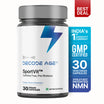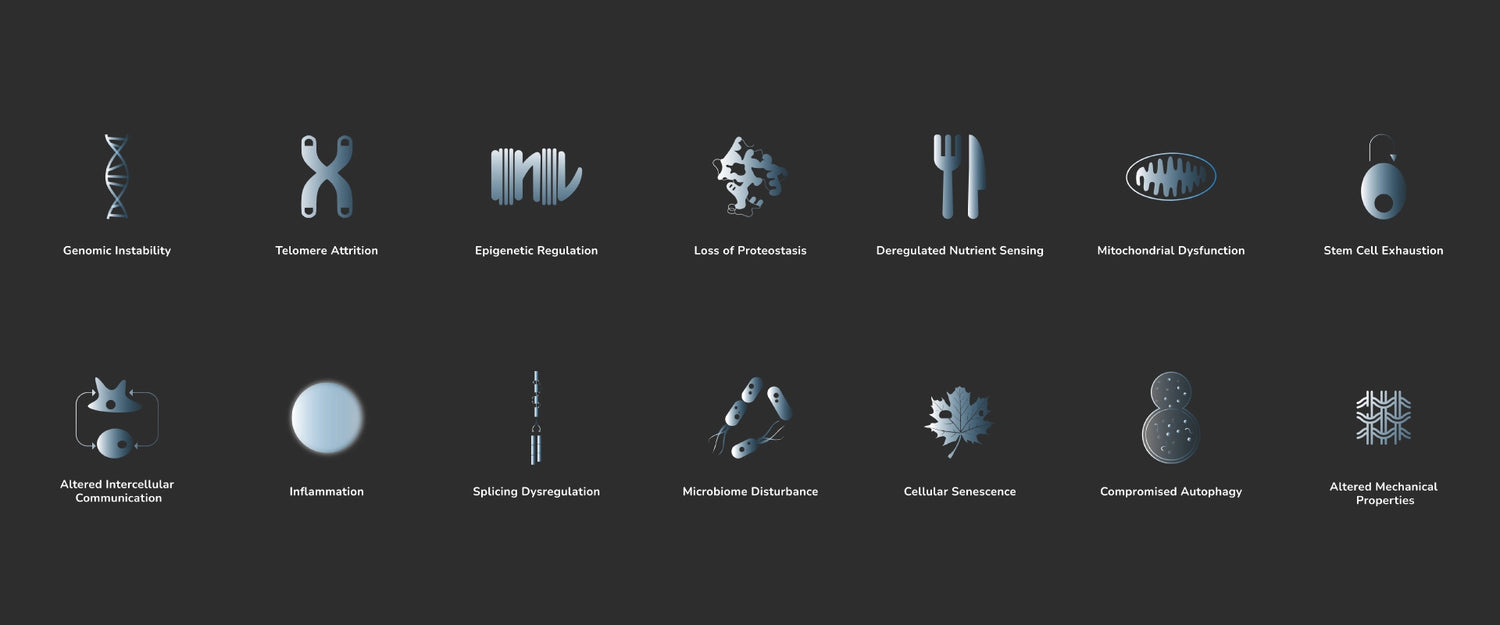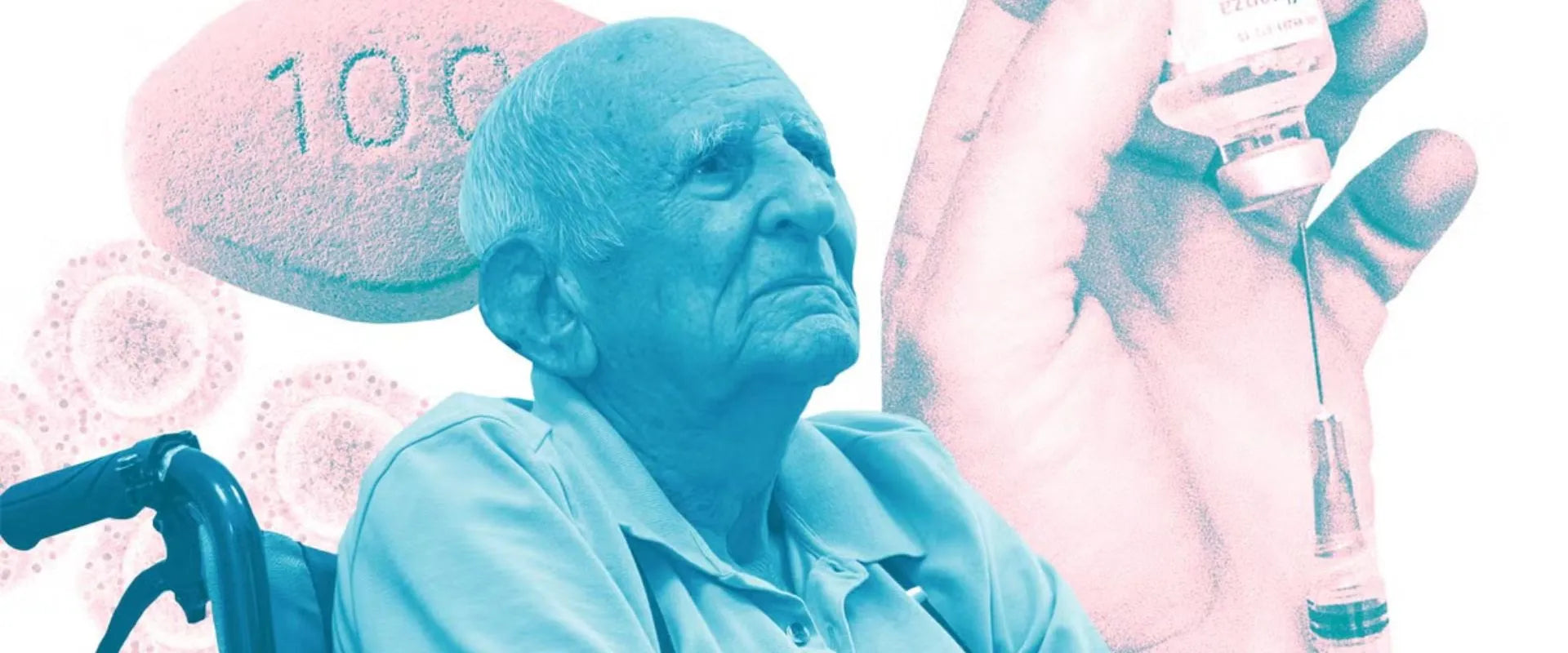One thing in this world that is constant is change. Change is inevitable and mankind is left with no option but to embrace it and mold itself in ways to accommodate those changes. One such jarring change is “ageing".
Ageing is inevitable as well as unavoidable but is preventable. We would seldom find a person who enjoys the consequences that come with ageing and hence a lot of masses are looking forward to reversing the signs of ageing and slowing the rapid process of it in this highly-stressful environment.
But before we find the golden elixir to slow down the ageing process, it is cathartic to first comprehend the root cause of it and the classic hallmarks of ageing. So grab yourself a healthy blend of smoothies (your gut will thank you for this), and curl up in your comfy place as we take you through each hallmark of ageing!
What is ageing?
Let us first define what the term "ageing" means before delving into the specific hallmarks of ageing. Growth and ageing are frequently equated, but that is rarely the case. In the simplest sense, growth in most cases is healthy, whereas ageing is mostly a degradation. our cells begin to deteriorate when growth ceases (López-Otín et al., 2013)
Growth occurs with the consumption of nutrients and metabolism of the food we consume, ageing on the other hand is defined as getting older and a gradual decline in one’s mental, physical, and physiological well-being. The only exception in today’s time is that it is not gradual anymore, if it is anything, it is rapid. Which ultimately leads to death.
The hallmarks of ageing
A 2013 Study intricately elaborated on the various causes and characteristics that contribute to ageing. ageing is not a result of one factor but de facto an amalgamation of 9 distinct phenomena, intertwined delicately. The revelation of the hallmarks of ageing has changed the science of longevity and is giving researchers more opportunity to work on the specific hallmarks or problems we might say to reverse ageing and enable the population to live a healthy, happy, and long life.
The distinct hallmarks of ageing are: 1. Genomic Instability 2. Telomere attrition 3. Epigenetic regulation 4. Loss of proteostasis 5. Deregulated nutrient sensing 6. Mitochondrial dysfunction 7. Cellular senescence 8. Stem cell exhaustion 9. Altered intercellular communication. A few of the hallmarks are discussed below.
Genomic instability

The total genetic makeup of an individual's cell is referred to as their "genome". The literal translation of genomic instability is defined as excessive damage to the genetic material i.e. the DNA, that impairs the normal functioning of the body leading to a paced-up ageing process. The marvellous human body is designed in a way that has various mechanisms that work in an orchestrated manner to instantly repair the damaged DNA. But when a certain threshold is crossed, these repair mechanisms fail to work and favour the ageing process. (Belancio et al., 2014) This marks the first hallmark of ageing to be instability in the genome.
What does it cause?
Imagine a typing error in a critical report causing confusion. Similarly, since our genetic makeup is like a blueprint of our entire system, a small error (mutation) can lead to cancer, impaired cell function, genetic disorder, developmental abnormalities and age-related disordered. genetic "typos" can cause cancers, impaired cell function, or even cell death.
Telomere attrition

Our genetic material is stored in a condensed structure, called chromosomes. These chromosomes have cap-like construction at the end which are termed “telomeres”. Telomeres consist of repeated DNA sequences. Whenever cell division occurs, the length of a chromosome is reduced by between 25 to 200 bases (A, C, G, or T), and the only portion of the chromosome that is lost, however, is the telomere. This leaves the major portion of the DNA unharmed because the ends of the chromosomes are protected by telomeres. Had it not been for telomeres, the majority of crucial regions of the DNA would be lost every time a cell divides. This would ultimately result in the deletion of whole genes.
As we age, the length of the telomeres shortens and reaches a “critical length” where the chromosome fails to replicate any further. This "critical length" causes the cell to undergo apoptosis, also referred to as programmed cell death. Telomerase is a type of enzyme that aids in the formation of those repeated sequences present in the telomere. The cells of our body lack a high concentration of telomerase as we age and thus enhance the ageing process. This entire phenomenon is termed telomere attrition, one of the hallmarks of ageing (López-Otín et al., 2013)
What does it cause?
Due to repetitive shortening, it can eventually break down and cause premature cell death with an increased chance of mutation and age-related disorders. I
How can it be repaired?
A Healthy lifestyle along with supplementation of Trans-Resveratrol, may slow down telomere shortening by activating the enzyme telomerase.
Epigenetic alterations

Epigenetics is the study of how DNA interacts with the plethora of smaller molecules that are located inside of cells that have the ability to activate and deactivate genes. In epigenetics, the changes occur “on” the DNA sequence rather than “in” the sequence as seen in mutation. Despite having essentially the same genomes, each person is distinct because of epigenetics. Epigenetic modifications can enhance or hinder the transmission of specific genes.
In simpler terms, epigenetic changes can either silence a gene i.e inhibit its expression by suppressing its transcription, or enhance its transcription by making it more available. All the chemicals that regulate this are collectively called the “epigenome”. DNA-methylation is one of the epigenetics phenomena where the attachment of methyl groups on the DNA renders its transcription. Epigenetics is largely associated with environmental and social alterations leading to the loss of important epigenomes, thereby enhancing the ageing process. (Stephens et al., 2013)
What does it cause?
Since it alters the way our genes are expressed, it can cause cancer, silence important genes and lead to age-related disorders.
How can it be repaired?
Supplements like Ginger, AKG, L-Glycine, Curcumin, and Apigenin may help manage our genes' activity and mitigate ageing effects.
Loss of proteostasis

Proteins are the macromolecules and the end products of the transcription-translation machinery. Proteins largely determine the characteristics and function of a cell. Many of our cell constituents are made repeatedly which results from the degradation of previously formed components. This degradation is achieved through the mechanism of “autophagy”. Autophagy degrades the cell or its component which is no longer functional or necessary. An alteration in this system leads to a buildup of redundant damaged cells, contributing more to the signs of ageing.
Repeated exposure to environmental hazards, unhealthy diet, and stress impairs this function and ultimately leads to protein misfolding or unfolding. For instance, it has been determined that the pollutants in contaminated air are particularly harmful agents in this regard, exacerbating a number of diseases associated with ageing.
What does it cause?
When the balance of building blocks (proteins) is off, the structure can collapse. This can lead to protein misfolding, cellular dysfunction, oxidative stress, age-related and neurodegenerative diseases like Alzheimer's, Parkinson's, and others.
How can it be repaired?
Supplements such as NMN, L-Glycine, EGCG, and Fisetin can potentially aid in maintaining the balance between protein creation and removal, assisting in cell health.
Deregulated nutrient-sensing

The IGF-1 and insulin pathway is a way that our body senses nutrients and controls lifespan. This pathway works with other systems that sense things like amino acids and energy levels. Some of these systems work in the opposite way, sensing the breakdown of molecules. Studies have shown that when these pathways are activated, it can lead to healthy ageing.
Researchers have found that by using drugs like rapamycin, which mimic the effects of calorie restriction, they can activate these pathways and promote health and longevity in mice.
What does it cause?
When cells overact or underreact due to deregulated nutrient sensing, it loses their ability to sense and process nutrients leading to obesity, diabetes, inflammation, hormonal imbalances and organ dysfunction.
How can it be repaired?
Supplements like NMN, Ginseng, Trans-Resveratrol, NAC and ALA may assist in correcting the cells' perception of nutrients, aiding metabolic health.
Mitochondrial dysfunction

While we all know the popular statement “mitochondria is the powerhouse of the cell” few are aware that it plays a significant role in the ageing process. In addition to producing ATP, the energy currency of our body, mitochondria also serve as sensors for cellular distress and are sensitive to the signs of cell death.
The involvement of mitochondria in controlling inflammation in response to metabolic changes (through mitochondrial sirtuins) has become more apparent ever since the study came into existence. Mitochondrial functioning has significant implications on the ageing process. Mitochondrial dysfunction brought on by various mechanisms, accelerates ageing through different means (Trifunovic & Larsson, 2008)
What does it cause?
When mitochondrial function is disrupted, it can have widespread effects on various cellular processes and overall health and lead to metabolic as well as genetic disorders.
How can it be repaired?
Supplementation with CoQ10 and NMN, both are beneficial for mitochondrial health.
Cellular senescence

Senescence is defined as a “pause” in the normal cell cycle which is the consequence of an injury. The accumulated senescent cells are eliminated by the immune system but this system is impaired in older tissues. These accumulated senescent cells begin to release inflammatory signals that damage our healthy tissues (van Deursen, 2014)
What does it cause?
These senescent cells not only eat up resources but also contribute to ageing, inflammation, tissue dysfunction and impaired wound healing. Over time they can also release harmful substances
How can it be repaired?
Senolytic supplements like Fisetin, Quercetin, and Apigenin can potentially help eliminate senescent or 'zombie' cells, reducing inflammation and promoting healthier ageing.
Stem cell exhaustion

Stem cells are special cells in our body that have the ability to turn into different types of cells and help regenerate or repair damaged tissue. However, as we age, the ends of our chromosomes, called telomeres, can shorten, which causes the stem cells to lose their ability to regenerate and repair as effectively. This can lead to age-related diseases because our body is not able to maintain and repair itself as well.
This effect applies to important bodily functions such as blood cell production and immune cell proliferation. When stem cells run out, the body and its tissues start to age. Recent studies suggest that rejuvenation therapies for stem cells might help reverse the effects of ageing and allow them to function better.
What does it cause?
When stem cell exhaustion occurs, it can have several implications and consequences, depending on the specific type of stem cells affected and the tissues they normally contribute to. Reduced tissue regeneration, accelerated ageing, organ dysfunction, and increased susceptibility to diseases are some of the consequences of stem cell exhaustion.
How can it be repaired?
Supplements like NMN and Ca-AKG may help rejuvenate the body's stem cell populations, promoting repair and renewal.
Altered intracellular communication

As we age, the way our cells communicate with each other can change. This communication usually happens through specific pathways called signalling pathways. These pathways can be improved to slow down the ageing process. Some examples of changes in cell signalling as we age include inflammation, changes in brain chemical signalling, and a decrease in the activity of a protein called IGF-1.
What does it cause?
When cell 'chit-chat' breaks down, it's like a team working without coordination, leading to inflammation, weakened immune response and impaired signal transduction.
How can it be repaired?
Senolytic activators like Apigenin, has anti-inflammatory properties, helping maintain cell communication.
Compromised autophagy

Autophagy, which is the process of cell "clean-up," is weakened in many age-related conditions like the ageing of the nervous system and the weakening of the immune system. However, by activating autophagy, scientists were able to extend the lifespan of mice and improve the immune response of older people to vaccines. Although autophagy was initially classified under "altered proteostasis," it actually regulates various other aspects of ageing, such as DNA repair and metabolism, and is thus proposed to be classified as an "integrative hallmark."
What does it cause?
If waste piles up in a city, it becomes a breeding ground for diseases. Similarly, compromised autophagy can lead to the accumulation of damaged proteins and organelles leading to conditions like Alzheimer's, Parkinson's, and cancer.
How can it be repaired?
Supplements like Spermidine, and NMN, promote autophagy, helping to clear cellular junk.
Dysregulation of RNA processing

Studies on ageing populations have found that there are issues with how RNA is processed in the body . Interventions that can help reverse the effects of ageing seem to work by restoring the way splicing factors are expressed in the body. There are also changes in the way mRNAs are polyadenylated, which is known to contribute to cancer and may play a role in senescence. These changes in RNA processing are another factor that affects how genes are expressed in addition to genome integrity, transcriptional efficiency, and epigenetic regulation, all of which are known to be affected by ageing.
What does it cause?
A poorly edited film can confuse viewers; similarly, dysregulated splicing can cause various diseases, including cancer and neurodegenerative diseases.
How can it be repaired?
No specific supplement identified yet for splicing dysregulation. General health maintenance with diet, exercise, and regular medical check-ups is advisable.
Microbiome disturbances

As we age, our gut microbiome - the bacteria and other microorganisms in our digestive system - can undergo significant changes. These changes, which can result in a loss of diversity among the microorganisms, are now detectable through new technologies that analyze the microbiome. This loss of diversity can contribute to inflammation in the body, particularly when combined with other age-related changes that can weaken our defences against harmful substances.
What does it cause?
Disturbances in the gut microbiome can cause gut issues, and obesity, and influence mental health.
How can it be repaired?
Diving deep into your gut to understand it and take appropriate measures. Decode Biome test is a specialised test for microbiome testing. Probiotic supplements and a fiber-rich diet can help maintain a healthy gut microbiome.
Altered mechanical properties

As we age, both our cells and the surrounding environment change in ways that affect their mechanical properties. For instance, in fibroblast cells, ageing causes a shift from a flexible actin pool to stable stress fibres, which impacts their ability to move and communicate with other cells. In the innate immune system, older neutrophils can cause tissue damage due to changes in signalling pathways that affect their movement. The structure of the cell nucleus is also affected, with destabilisation of the nuclear lamina and chromatin extrusion leading to senescence. Additionally, changes to the extracellular matrix can cause stiffness and loss of elasticity, leading to age-related diseases such as hypertension and diabetes. The study of mechanobiology concerning ageing shows great promise for improving cellular function and slowing down the ageing process.
What does it cause?
A rusty machine can break down or malfunction. Similarly, these changes can cause heart disease, lung disease, osteoarthritis, and other age-related conditions.
How can it be repaired?
Regular physical exercise and mobility activities can help maintain tissue elasticity and strength. Supplementation with CoQ10, and NMN might be beneficial for tissue health.
Inflammation

Inflammation plays a significant role in age-related diseases and is known as inflammageing. As we age, we often experience chronic inflammation, which is linked to higher levels of inflammatory markers like IL-1, IL-6, C-reactive protein, and IFNα in our blood. Inflammation was originally viewed as part of altered intercellular communication, but it is now recognized as a separate hallmark due to its significant impact on the ageing process. It also interacts with other hallmarks such as cellular senescence and the newly proposed gut microbiota.
What does it cause?
Chronic inflammation can damage tissues and organs and lead to autoimmunity, heart disease, diabetes, and cancer.
How can it be repaired?
Supplements like Quercetin, Apigenin, and Fisetin have anti-inflammatory properties that may help control chronic inflammation, a key contributor to many age-related conditions.
Conclusion
Ageing is a complex and multifaceted process that involves numerous interconnected mechanisms. By examining the 12 hallmarks of ageing, we can gain a deeper understanding of the ageing process and its impact on our bodies. This knowledge can guide future research and help develop novel interventions aimed at promoting healthy ageing and extending our healthspan. As we continue to unlock the secrets of ageing, the possibilities for a healthier, longer life become increasingly attainable.
Future Perspectives
As our understanding of the ageing process continues to grow, so does the potential for innovative interventions and therapies. Advances in technology and scientific research provide new opportunities to explore the molecular and cellular mechanisms behind ageing, leading to the development of targeted therapies and personalized medicine approaches. Here, we discuss some of the potential directions that ageing research may take in the coming years.
Targeting Ageing Hallmarks with Novel Therapies
As the 12 hallmarks of ageing continue to be elucidated, researchers are developing targeted therapies to address specific aspects of the ageing process. Such interventions could include small molecules, gene therapies, or even cellular therapies that specifically target one or more hallmarks of ageing, leading to improved healthspan and quality of life for individuals as they age.
Longevity and Healthspan Enhancement
Research into the molecular and cellular processes that contribute to ageing may uncover strategies for enhancing longevity and healthspan. By targeting the underlying mechanisms of ageing, it may be possible to delay the onset of age-related diseases and promote overall health and well-being. This could lead to a paradigm shift in the way we approach ageing, focusing on proactive, preventive measures rather than simply treating the symptoms of age-related decline.
Personalized Ageing Interventions
With the advent of personalized medicine and advances in genomics, researchers are now able to better understand the individual factors that contribute to the ageing process. This knowledge will enable the development of personalized ageing interventions tailored to an individual's unique genetic makeup and environmental exposures. By accounting for these personal factors, we can optimize interventions for maximum effectiveness and minimize potential side effects.
Artificial Intelligence and Ageing Research
Artificial intelligence (AI) has the potential to revolutionize ageing research by providing powerful tools for data analysis, prediction, and discovery. AI can help identify novel molecular targets, optimize intervention strategies, and analyze complex interactions between the various hallmarks of ageing. By leveraging AI, researchers can accelerate the pace of discovery and bring innovative therapies to the forefront more quickly.
Embracing the Future of Ageing Research
The future of ageing research is promising and filled with exciting possibilities. As we continue to unlock the secrets of ageing and develop novel interventions to target its underlying mechanisms, we move closer to a world where ageing is no longer synonymous with decline and disease. Instead, we can look forward to a future where healthy ageing and extended healthspan are not only possible but attainable for everyone.
Collaboration and Multidisciplinary Approaches
One of the most promising aspects of future ageing research is the increasing collaboration and multidisciplinary approaches among scientists from diverse fields. The complex nature of the ageing process demands expertise from various disciplines, including genetics, epigenetics, cell biology, immunology, bioinformatics, and more. By fostering collaboration and knowledge exchange, we can accelerate the pace of discovery and develop more effective interventions to target the hallmarks of ageing.
Integration of Lifestyle and Environmental Factors
Ageing research has traditionally focused on the molecular and cellular aspects of the process. However, there is growing recognition of the importance of lifestyle and environmental factors in determining healthspan and longevity. Future research will likely integrate these factors more extensively, examining the interplay between genetic and environmental influences on ageing and identifying interventions that optimize both aspects to promote healthy ageing.
Public Health and Policy Implications
As our understanding of the ageing process deepens, there will be growing implications for public health policy and healthcare delivery. Ageing research can help inform public health strategies to promote healthy lifestyles and reduce the burden of age-related diseases on healthcare systems. Moreover, policymakers will need to consider the societal and economic consequences of an ageing population and develop policies that support older individuals while maintaining the sustainability of social and healthcare systems.
Education and Public Awareness
Finally, as we continue to unlock the secrets of ageing, it is crucial to raise public awareness and educate people about the importance of healthy ageing. By promoting a better understanding of the ageing process and empowering individuals with knowledge, we can encourage healthier lifestyles and help people make informed decisions about their health and well-being. This, in turn, can contribute to a society where healthy ageing is not only a possibility but a reality for all.
A Brighter Future for Ageing
The field of ageing research has come a long way, and our understanding of the ageing process has grown tremendously in recent years. With the identification of the 12 hallmarks of ageing and ongoing advancements in scientific research, we stand at the cusp of a new era in our quest to unlock the secrets of ageing. By embracing multidisciplinary approaches, integrating lifestyle and environmental factors, and fostering collaboration across disciplines, we can continue to push the boundaries of our knowledge and work towards a future where healthy ageing is attainable for everyone.
References:
Belancio, V. P., Blask, D. E., Deininger, P., Hill, S. M., & Michal Jazwinski, S. (2014). The aging clock and circadian control of metabolism and genome stability. Frontiers in Genetics, 5(DEC). https://doi.org/10.3389/fgene.2014.00455
López-Otín, C., Blasco, M. A., Partridge, L., Serrano, M., & Kroemer, G. (2013). The hallmarks of aging. In Cell (Vol. 153, Issue 6, p. 1194). Elsevier B.V. https://doi.org/10.1016/j.cell.2013.05.039
Stephens, K. E., Miaskowski, C. A., Levine, J. D., Pullinger, C. R., & Aouizerat, B. E. (2013). Epigenetic Regulation and Measurement of Epigenetic Changes. Biological Research for Nursing, 15(4), 373–381. https://doi.org/10.1177/1099800412444785
Trifunovic, A., & Larsson, N. G. (2008). Mitochondrial dysfunction as a cause of ageing. Journal of Internal Medicine, 263(2), 167–178. https://doi.org/10.1111/j.1365-2796.2007.01905.x
Van Deursen, J. M. (2014). The role of senescent cells in ageing. In Nature (Vol. 509, Issue 7501, pp. 439–446). Nature Publishing Group. https://doi.org/10.1038/nature13193
Schmauck-Medina, T., Molière, A., Lautrup, S., Zhang, J., Chlopicki, S., Madsen, H., ... Fang, E. (2022). New hallmarks of ageing: A 2022 Copenhagen ageing meeting summary. Aging, 14(16), 17006-17026. doi: 10.18632/aging.204248






















